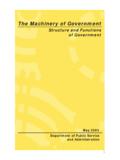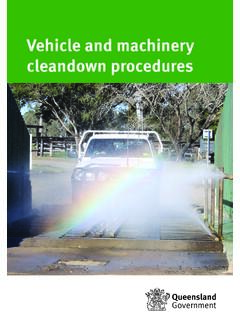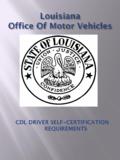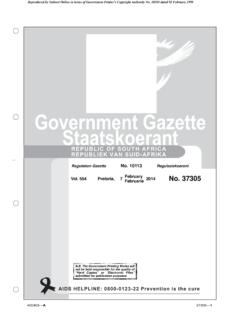Transcription of ‘Caught In-Between’ Hazards
1 FOCUS 4 Caught In-Between HazardsTrainer GuideCONSTRUCTION SAFETY & HEALTHThis material was produced under grant number SH-16586-07-06-F-36 from the Occupational Safety and Health Administration, Depart-ment of Labor. It does not necessar ily refl ect the views or policies of the Department of Labor, nor does mention of trade names, commercial products, or organizations imply endorsement by the #3 | Trainer Guide1 Caught in-between HazardsSECTION #3 Caught in-between Hazards Caught in-between Hazards kill workers in a variety of ways. These include: cave-ins and other Hazards of excavation work; body parts pulled into unguarded machinery ; standing within the swing radius of cranes and other construction equipment; caught between equipment & fi xed AND TRENCHING HAZARDSE xcavation Hazards are common on construction sites.
2 These workers are more than twice as likely to be killed as workers in any other type of construction work. Excavations and trenches are unstable by nature, and many types of serious Hazards exist when doing this type of CAN GO WRONG ON AN EXCAVATION? Cave-ins can SUFFOCATE OR CRUSH workers. Hazardous atmospheres can KILL OR INJURE workers: Oxygen defi ciency can SUFFOCATE a worker. Flammable gases or vapors can cause FIRES and EXPLOSIONS. Toxic gases or vapors can kill or seriously injure workers. Workers can DROWN in water, sewage or chemicals if these haven t been controlled by diverting them elsewhere or locking them out to prevent worker exposure. Workers can face BURNS, ELECTROCUTION OR EXPLOSIONS while working around various underground utilities, such as steam, hot water, gas, electricity.
3 CAVE-INS can happen: 1. when the soil is unstable;2. when there is a lot of vibration from trains, trucks, traffi c or machinery ;3. when there is too much weight, too close to sides of the excavation, from excavated material ( spoils ), tools, equipment, materials or vehicles at the site;4. when there is water in the excavation; or5. when there are changes in the weather, like heavy rain, freezing, melting, t get caught! Take the proper precautions to ensure that you are working safely. Wear all required personal protective equipment. A mistake in excavation/trenching procedures may not give you a second chance!Excavations and trenches are unstable by nature, and many types of serious Hazards exist when doing this type of #3 | Trainer Guide2 Caught in-between HazardsMEXERCISEMWhat s Wrong With This Excavation?
4 Read the story and answer the questions: you should use the fact sheet that follows the story to help you answer the rep Bob Smith called the manager of ABC Company to insist that an unprotected excavating job be shut down immediately. He had received a call from his union safety steward, Jim Riley, about the problems at the site. The day before, Jim complained to his supervisor that a deep trench (about eight (8) feet deep), which was about four (4) feet wide at its base, was not shored (the sides of the trench weren t supported to prevent a cave-in). The supervisor told Jim to shore it himself, which he tried to Jim came to work the second day, he saw some of his co-workers working in a second trench, which was also not shored.
5 Excavated material was piled high, right at the edges of both trenches. Both trenches were about eight (8) feet deep. Workers were trying to repair a broken steam line. The steam line had been previously locked out and drained at the power plant supplying the one hour, Bob and an OSHA inspector arrived at the site after the union got management to shut down the job. The union acted because workers were exposed to imminent danger to life or serious harm and the management of ABC Company had refused to cooperate with the union steward s efforts to do the job safely. When the inspection took place, the OSHA inspector found: the soil content was 87 percent sand; t he depth of the two excavations was eight (8) feet, plus the height of the excavated material piled right on the edge; there was no shoring or other protective system on one of the excavations; there was inadequate sloping and shoring in the other excavation; the workers were not trained, and didn t know how to properly construct shoring or other protective Work: Workers are in a trench more than fi ve (5) feet deep, with no protective system in #3 | Trainer Guide3 Caught in-between HazardsNQUESTIONSN1.
6 What happened at this excavation site? Employer failed to follow any of the OSHA standards for excavations. Quick action by the steward and the union helped to prevent a serious What were some of the violations of trenching safety? No soil classifi cation was done, , the type of soil was not determined No competent person when setting up a protective system Workers not properly trained to work in an excavation No competent person inspecting the excavation before entering3. What kind of soil type was present at this excavation, and what should this have told the responsible people at the site? It was 87 percent sand, Type C soil. This should have told management that the soil was very What was wrong with the way material was removed from this excavation?
7 Material was piled high right at the edge of the trench it should be at least three feet away. (NOTE: the OSHA standard says it must be at least two feet away; three feet away from the edge is safer.) If the soil is piled too close to the side of the trench, it adds weight to an unsupported edge, increasing the likelihood of a What training should have been done to protect these workers? Only a competent person authorized by the employer can act to correct hazardous conditions at the excavation site. All involved workers need training on excavation Hazards and how to protect #3 | Trainer Guide4 Caught in-between HazardsNSUMMARYNP rotect Yourself On Excavation Sites1. OSHA requires a competent person to be on-site when doing excavations.
8 That person must be able to recognize Hazards that exist and Hazards that could occur, and that person must have the authority to take action to correct those conditions. S/he must also inspect the excavation, the surrounding areas, and the protective systems every day before the start of For all excavations and trenches deeper than 5 feet, but less than 20 feet deep, you must use one of three methods: a. Sloping or benching. Sloping involves cutting back the sides of the trench to a safe angle so it won t collapse. Benching is a variation that adds a series of benches (steps) that also approximate the safe sloping angle. The angle that you use for sloping depends on the soil type. Soil types are: Solid rock, Type A, Type B and Type C (which is the least stable).
9 However, using a cutback slope of 1-1/2 feet horizontal to 1 foot vertical is a safe sloping angle for all soil types. Note: Type C soil can only be sloped: it s too unstable to be benched. Sloping: The safe angle for the slope depends on the soil type. A slope of feet Horizontal to 1 Foot Vertical (Type C slope) is safe for all soil : This is a safe method with Type A or Type B soil only. NOTE: Graphic is for illustrative purposes only. Actual dimensions of vertical walls and horizontal benches will be larger, and these dimensions will vary by soil type: Type A or Type B (see OSHA standards).SECTION #3 | Trainer Guide5 Caught in-between HazardsORb. Trench box or shield: Although these are NOT designed to prevent cave-ins, they should protect workers within the structure if a cave-in B ox: This worker will be safe as long as he stays inside the trench box while performing his Shoring: These are structures built of timber, or they can be mechanical or hydraulic systems, that support the sides of an excavation.
10 Sheeting is a type of shoring that keeps the earth in : The worker in the excavation is protected by a shoring system.(But watch out for that ladder! It doesn t extend at least three (3) feet above the top of that wall for safe access and egress.)SECTION #3 | Trainer Guide6 Caught in-between Hazards3. With shoring and shielding, workers are only protected as long as they stay within the confi nes of the If the competent person sees signs of a possible cave-in, even at depths less than 5 feet, one of the protective systems must be If the excavation is more than 20 feet deep, a professional engineer must design the system to protect the A ladder, stairway or properly designed ramp is required in any trench 4 feet or deeper at least every 25 lineal feet of the trench.



















